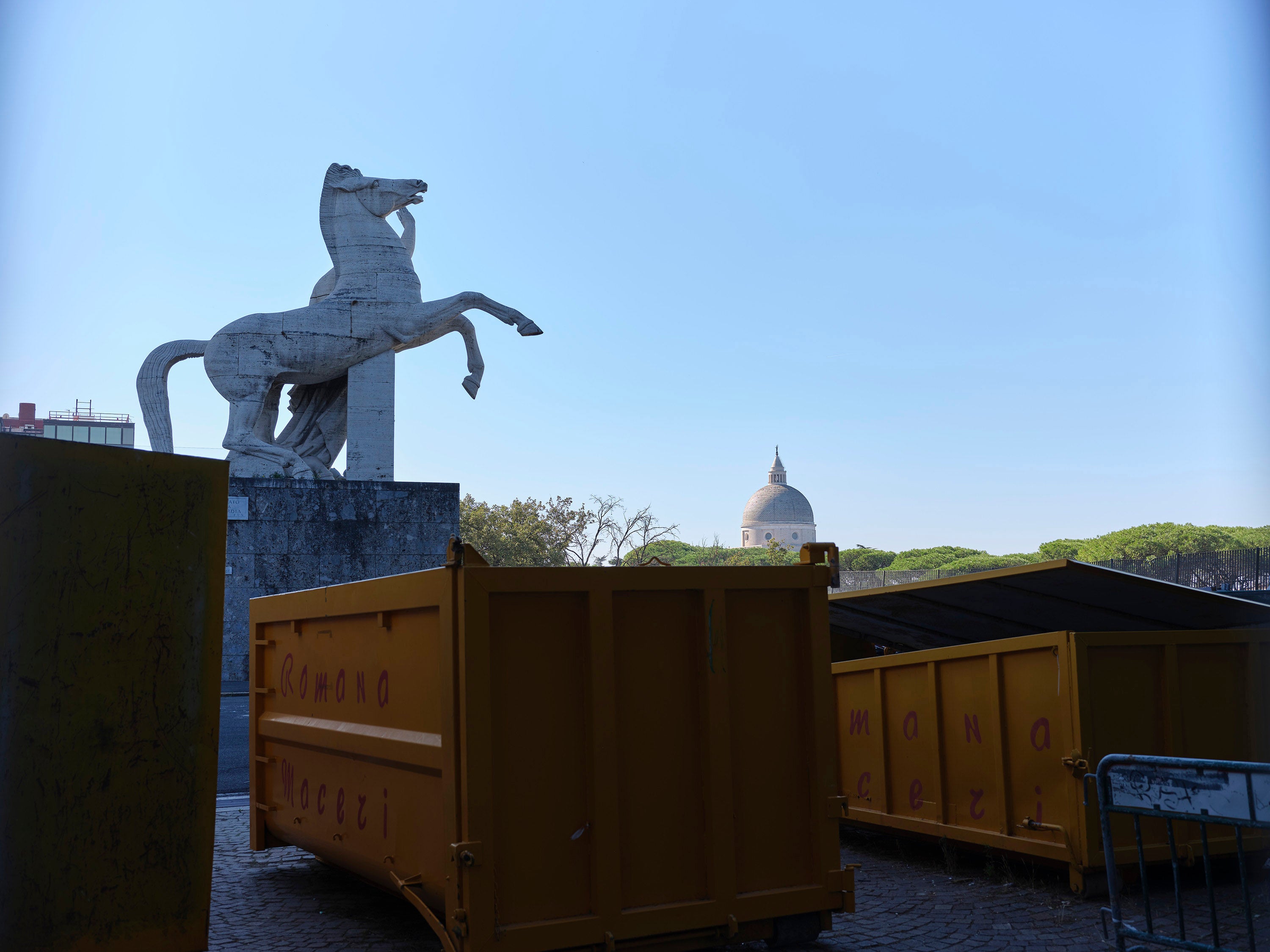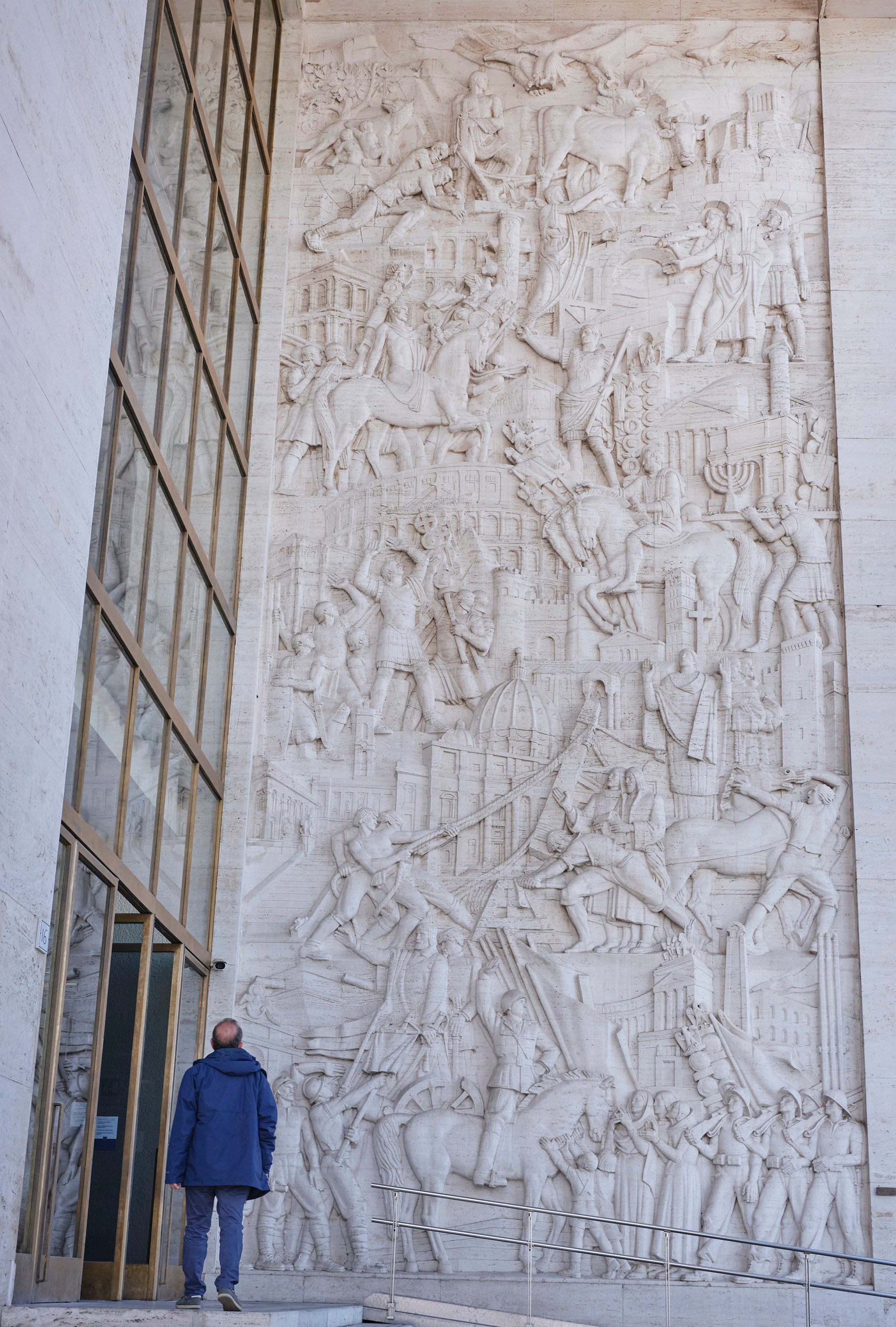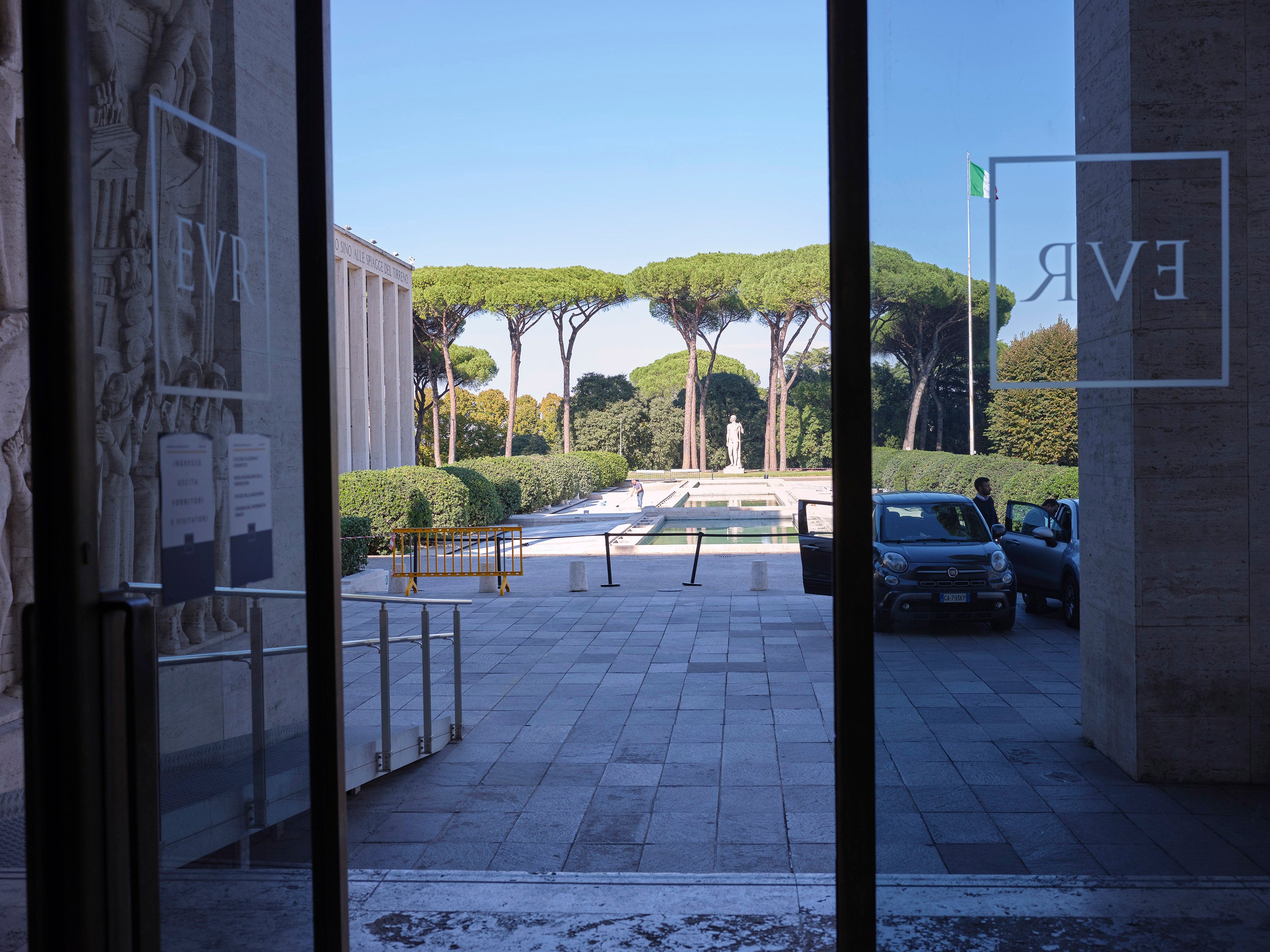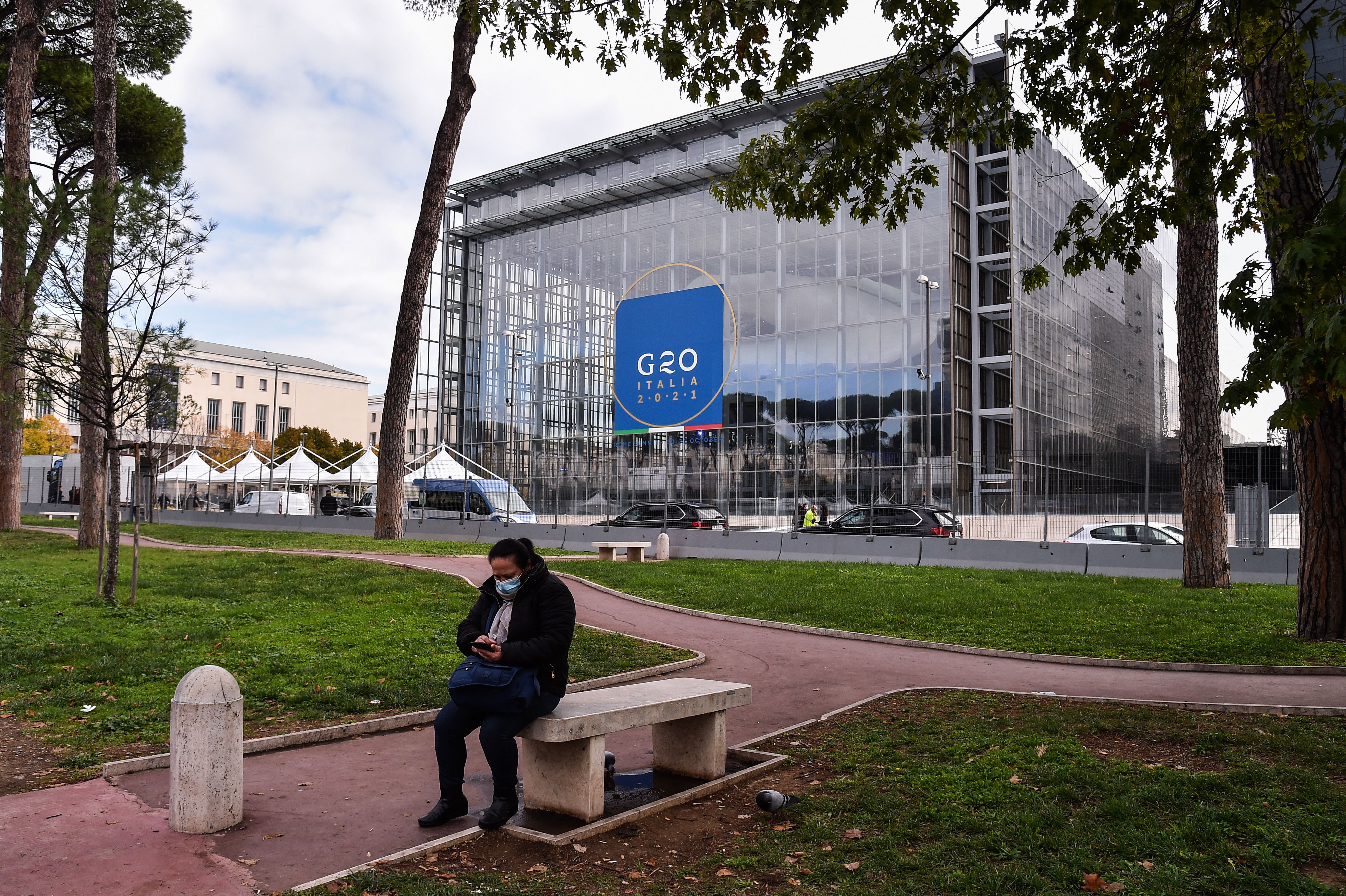G20: A Roman neighbourhood built as a fascist showpiece finds its purpose
EUR, Italy was never used for its original purpose of hosting the 1942 World’s Fair but now this glimpse of an old, fascist Italy is getting its chance on the world stage, writes Chico Harlan and Stefano Pitrelli

Your support helps us to tell the story
From reproductive rights to climate change to Big Tech, The Independent is on the ground when the story is developing. Whether it's investigating the financials of Elon Musk's pro-Trump PAC or producing our latest documentary, 'The A Word', which shines a light on the American women fighting for reproductive rights, we know how important it is to parse out the facts from the messaging.
At such a critical moment in US history, we need reporters on the ground. Your donation allows us to keep sending journalists to speak to both sides of the story.
The Independent is trusted by Americans across the entire political spectrum. And unlike many other quality news outlets, we choose not to lock Americans out of our reporting and analysis with paywalls. We believe quality journalism should be available to everyone, paid for by those who can afford it.
Your support makes all the difference.In the Roman neighbourhood known as EUR, all the classic telltales of Rome drop away. Gone are the cobblestone roads, the antiquities, the worn palazzi dappled like watercolours. What you get instead are broad boulevards and imposing white buildings, plus a man-made lake. Everything is orderly, planned. Look in the right direction, and you'll even see a sculpture heroically depicting the planner: Benito Mussolini.
Conceived as a fascist showpiece for an event that never happened – war cancelled the 1942 World’s Fair – EUR is getting a chance eight decades later to serve as a backdrop for a global gathering: this time, the Group of 20 summit.
Reminders of what EUR (pronounced ay-oor) was supposed to represent are still vivid. Mussolini had hoped it would stand as an example of an ideal city, with gardens and open spaces, and he commissioned some of the most acclaimed Italian architects and artists to remake land used previously only by farmers and an abbey of cloistered monks. EUR’s boundaries were marked off in a near-perfect pentagon. Mussolini planted a tree at the 1938 groundbreaking.
But today, EUR also has lanyard-wearing office workers eating £9 salmon wraps. It has monuments designed to glorify the fascist ideal that now house global companies, such as Fendi. It has a couple of eerie blocks almost resembling Pyongyang – empty, colossal and colonnaded – but it also has dentist and chain restaurants, energy company headquarters and upper-middle-class apartments.
“What I’ve often heard is that a neighbourhood like this could only be built by a dictator,” says Lorenzo Volpato, a self-described leftist who lives and works in EUR and called the neighbourhood pleasant regardless of the fascist markers. “It’s got metro stations. It’s modern. It’s more liveable than Rome.”
Eventually, it became a sort of alternative Rome – while showing what more of Italy might have looked like had Mussolini retained power
The neighbourhood has managed to grow – and normalise – in large part because of a Roman willingness to rebuild, move on and coexist with even the worst parts of the past. It’s especially striking at a time when monuments to enslavers, Confederate generals, kings and colonial leaders have come toppling down across the United States and other parts of Europe. In EUR, such monuments have become just a part of the low-slung skyline.
The neighbourhood is hosting the G20 in part because of its convenience: it’s spacious and easy to cordon off for security. It also has a modern, glass convention centre, completed in 2016, known to Romans as the Cloud, which until recently housed a coronavirus vaccination centre and where world leaders will be gathering this weekend.
“It was to be a place where you wouldn’t be bound by antiquity,” Luca Ribichini, a professor of architecture at Rome’s Sapienza University, says. “It was supposed to personify the new modernity.”
The plans, at least initially, fell into chaos. By 1945, the fascist regime had been toppled, Mussolini had been executed – his body hung upside down in public – and EUR was only half-completed, sealed off and all but abandoned.
But over the next decade, the postwar Italian government moved ministries to the area. Before the 1960 Olympics, construction firms built roads and apartment buildings and finished what the fascists had started. Eventually, it became a sort of alternative Rome – while showing what more of Italy might have looked like had Mussolini retained power.

“It’s this relic of a megalomaniacal project that has been turned into a business district,” says Agnes Crawford, a 20-year resident of Rome who leads private tours, including, occasionally, in EUR, where she said the museums are high-quality and crowd-free.
“But,” Crawford says, “it still retains some menacing overtones.”
Some of the fascist markers have been removed over the years. But other reminders remain. One of the most noteworthy is a large inscription at the top level of the Fendi building. The quote, without context, is fairly innocuous, paying tribute to Italians as a people of “poets, artists, heroes, saints, thinkers, scientists, navigators, migrants”. But that quote echoes a part of Mussolini’s 1935 speech announcing the invasion of Ethiopia, a campaign that later led to charges of war crimes.
Just a few blocks away, there is an even more overt Mussolini homage. It comes in the form of a towering bas-relief sculpture, selectively narrating the long history of Rome. The sculpture moves through time from top to bottom, starting with the mythological founding of the city by Romulus and Remus, continuing through the centuries with Roman conquerors returning with spoils from Jerusalem, and with the construction of St Peter’s Square. At the bottom of the sculpture there is one dominant image: Mussolini on horseback, surrounded by soldiers, as children and women lift their hands.
Sculpted in 1939, it stands at the entrance of a building housing EUR SpA, the company that owns many of the properties in the neighbourhood. Inside, there’s also a courtyard fountain inlaid with fascist eagles. In one of the conference rooms, sitting without fanfare in the corner, is a metal head of Mussolini.
“The debate about art and beauty goes far beyond the history of the most ferocious regimes,” says Antonio Rosati, the chief of EUR SpA, who says his politics lean left and he isn’t bothered by the remnants of Mussolini’s era.

There are numerous theories about why Italians have felt less of a need to fully remove the propaganda of a terrible time. One idea is that Romans have so much history, they didn’t feel compelled to single out the most recent horror. Some have noted that the fascist icons – unlike the Confederate monuments – were built contemporaneously, and don’t reflect some after-the-fact nostalgia for an earlier period.
For David Hannuna, a Jewish lawyer who was born and raised in EUR, the icons have never been a source of anger – instead, he says, they provide a reminder about progress.
“There was pride in being able to freely live, freely and openly practising our religion, in a place where in another time that would’ve been a problem,” he says.
Standing on a street corner, awaiting a tyre change, Claudio Foglia says he, too, never saw a problem with the propaganda-infused art and architecture in his 40 years of working in the neighbourhood, at the Italian energy firm Eni. But he is retired now. He has started reading more, including about fascism. He says he now worries that Italy “metabolised” fascism too quickly, and without fully addressing the sentiments that made it vulnerable. Just the previous weekend, a rally in Rome against the coronavirus Green Pass had turned violent, spurned in part by leaders of Forza Nuova, a neofascist group.
“It’s painful for an Italian to read these things and realise we haven’t dealt with them,” Foglia says. “We are acting as if nothing happened.”
One thing is clear about Mussolini’s aesthetic: he liked his buildings to be seen. He signed off on the demolition of entire neighbourhoods around the Vatican and the Colosseum, clearing the way for broad, showy thoroughfares that created sightlines for the most famous spots in the city. He used the same idea in EUR, where the most celebrated buildings are set off at wide distances from one another, connected by straight, flat roads.

One such road connects the Piazza della Civilta Italiana – the arched and statue-lined Fendi headquarters – with the Palazzo dei Congressi, a travertine-clad hall designed for conferences and events.
To some observers over time, the palazzo has felt intimidating in its geometric vastness. When TV travel documentarian Anthony Bourdain visited the facility for a 2016 episode, his film crews trained their cameras on a single custodian, cleaning a hall that Bourdain said had been designed to “dwarf the individual”.
For the G20, the palazzo is serving as a media centre. Large banners with the slogan “People, Planet, Prosperity” are draped outside, and on a recent afternoon, work crews were spread out in all areas, putting up prefabricated walls, building temporary meeting spaces or interview rooms.
An official from Eur SpA, which manages the building, leads a tour to the heart of the palazzo: a vaulted space with ample lighting, adorned in perforated material the colour of gold.
“It’s a perfect cube,” says one of the officials on the tour. It’s 124 feet high, wide and long. And for now it houses 72 media work desks.
The tour continues up to the roof deck – an area of rectangular benches, all cold marble – that was depicted as a mental institution in Bernardo Bertolucci’s classic 1970 film, Il Conformista (The Conformist). During the shooting for that film, the sky was nearly the same grey as the marble. The monochrome conveyed an eerie vibe.
But if you visit now on a gorgeous day, the marble benches glow. The severity is softened by olive trees growing from spots of soil interspersed along the roof. From way up here, you can see all of EUR – the apartments, the offices, the people ending their workdays.
The neighbourhood has at least one thing in common with the rest of Rome: the view at sunset is lovely.
© The Washington Post



Join our commenting forum
Join thought-provoking conversations, follow other Independent readers and see their replies
Comments